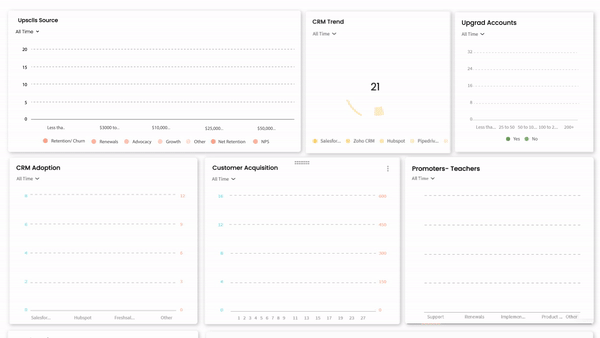Customer Experience
What is Customer Experience Analysis: A Comprehensive Guide
Article written by Parvathi Vijayamohan
Content marketer at SurveySparrow.
13 min read
11 December 2024

Did you know that businesses that offered positive customer experiences have improved their ROI by 6 times (Source: Forrester)? Believe it or not, it’s true. All the more reason for you to invest more in improving your customer experience.
So, how can you do it? Customer experience analysis.
It is all about listening to your customers, understanding their feedback, and finding ways to improve. Furthermore, it helps you learn what’s working and what needs fixing so you can keep your customers coming back.
In this blog, we’ll walk you through the steps of customer experience analysis and how to overcome the potential challenges.
What Is Customer Experience Analysis?
Understanding how the customers feel about your business and its offering - that's what customer experience analysis is.
It all starts by looking into every customer interaction with your business. This includes everything from visiting your website and talking to customer support to using your product.
The touchpoints can be of two kinds:
- Direct contact: Interactions initiated by your brand include one-on-one contact with customers. For e.g., customer outreach, product demos, email exchanges, or service calls.
- Indirect contact: Interactions that needn’t be initiated by your brand – but they do shape a customer’s impression of your business. For example, brand mentions on social media, word-of-mouth, or Google reviews.
The main aim here is to identify what customers like, what frustrates them, and what could be better.
Why Is It Important to Analyze Customer Experience?
At its core, analyzing customer experience equips businesses to build stronger relationships and drive sustainable growth. Understanding the interactions between customers and businesses is crucial in today’s market landscape. Here’s why measuring customer experience analysis is essential:
- Tailoring Offerings: It facilitates the alignment of products/services with customer desires.
- Competitive Differentiation: A stellar customer experience can set a brand apart.
- Fostering Loyalty: Positive engagements lead to repeat business and referrals.
- Feedback Utilization: Highlights areas for improvement, driving continual refinement.
- Revenue Enhancement: Satisfied customers often correlate with increased sales.
- Protecting Brand Image: Good experiences minimize negative feedback, enhancing reputation.
- Guiding Strategy: Insights from analysis steer data-informed business decisions.
The goal of customer experience analysis is to understand how your customers interact with, and experience your product or service. When done right, this will lead to:
- Better customer journeys
- Stronger customer retention
- Personalized customer experiences
- Understanding what current and potential customers want from their products and services.
- Creation of SOPs for issues that are affecting customer satisfaction.
73% of all people see customer experience as a key factor in their purchasing decisions. – PwC, Experience is Everything
How to Conduct Effective Customer Experience Analysis?
Here are 5 key steps to conducting a proper and thorough analysis of customer experience. Have a look at it.
#1. Identify Key Stakeholders and Customer Touchpoints

When running a business, it’s important to identify key stakeholders for two reasons:
- To ensure proper communication between everyone interested in the business’s success.
- Identifying stakeholders also helps to create accountability. It ensures that there are processes in place that allow the right people access to the right information.
And customer touchpoints? They help you break down customer interactions and their performance by channel. This is much more helpful than a bird’s eye view of your CX and can help you determine which media to optimize.
You can approach this first step with a customer journey map. In case you are starting from scratch, here are some channels you can start with:
- Onboarding new users
- Trial user feedback surveys
- Service requests and complaints
- Service and support interactions
- Chatbot interactions
- Email interactions
#2. Scrape Information on Customer Sentiment

In the next step, gather as much data as you can. There are a variety of tools you can use depending on the specific touchpoint.
- Surveys – especially customer and product feedback surveys – help you ask targeted questions about different areas of the customer experience, from onboarding to account cancellation. They are relatively quick, simple to implement, and easy to navigate on mobile screens.
- Interviews – provide detailed information based on individual experiences. According to Jim Tincher, it’s important to involve your teams in the interview – and the overall process itself. This will help them become a lot more invested in the results.
- Behavioral analytics tools – for analyzing user interactions with your website or app.
- Social media comments. Moreover, all major social media platforms have built-in analytics tools.
- Collecting reviews from customers. Tools like SurveySparrow make it simple to collect and consolidate customer reviews. You can also use our built-in conversation tracking to manage customer responses.
- Customer metrics like NPS, CSAT, or CES. These types of data are a good way to track overall changes in your CX and can be collected through surveys.
- Most CRM tools have a feature for collecting customer feedback. If not, integrations like SurveySparrow make it easy.
Want to craft surveys that truly gauge customer experience? Dive into SurveySparrow and see the magic unfold. Ready to get started? Sign up for a free trial here.
A personalized walkthrough by our experts. No strings attached!
#3. Analyze the data to identify potential areas of improvement
Let’s break it down:
- Create a benchmark of what you want your ideal CX to look like.
- Measure the data against this benchmark.
- Look for recurring patterns because they could indicate areas that need to be improved.
- Drill down using demographic (age, gender, etc.) and psychographic (interests, hobbies, etc.) data. This helps you segment customer types and understand which type is dissatisfied with which channel.
- Qualitative responses are hard to analyze. But you can pull out dominant themes and sentiments with wordcloud analysis.
Data analysis is a complex process. However, we have reporting features that can help you pull a mass of responses into actionable trends quickly.
#4. Develop a Customer Experience Strategy

You can develop an overarching strategy or break it down section by section.
For example, analyzing the data created by daily operations lets your staff know where they excel, where problems exist, and the training required to fix them.
However, take the time to study the data, and don’t rush to conclusions based on the numbers.
After all, the data indicates that a problem exists, but it may not point to a specific cause. The problem might only be at the customer’s level. Or it can be due to a bigger cause like a product issue, a policy, or the employee’s mindset.
Related Read: How to Create a CX Strategy That Works?
#5. Measure Your Progress and Adjust the Strategy Accordingly
It is important to measure the progress of your customer experience analysis and adjust your strategy accordingly. This will help your brand deliver a better customer experience and stay ahead of the competition.
To do this, you should regularly track customer feedback from all sources available. But don’t stop there – use this data like a tool to manage customer relationships actively.
3 Key Metrics for Effective Customer Experience Analysis
To understand how your customers feel about your business, tracking the right metrics is essential. Here are three key metrics that provide valuable insights into customer experience:
1. Net Promoter Score (NPS®)
NPS® is like the most important metric to calculate customer loyalty and satisfaction. It measures how likely customers are to recommend your business to others on a scale of 0 to 10.
Pro Tip: Use SurveySparrow to easily calculate NPS® and identify promoters, passives, and detractors in your customer base.
2. Customer Satisfaction Score (CSAT)
CSAT score is a metric used to measure customer satisfaction with a product, service, or specific interaction. Customers are asked to rate their satisfaction level on a scale of 1 to 5 or 1 to 10.
A higher CSAT score would indicate a higher satisfaction level among customers.
3. Customer Effort Score (CES)
CES measures how much effort customers have to put in to get their issues resolved or achieve their goals. Lower effort means higher satisfaction and greater chances of repeat business.
5 Common Challenges in Customer Experience Analysis and How to Overcome Them
Customer Experience analysis is critical for understanding how your customers feel about your business. However, it often comes with challenges that can slow down progress.
Below is a detailed look at the most common obstacles and simple ways to tackle them.

1. Low Survey Response Rates
Customers often ignore surveys or leave them incomplete, leaving you with too little data to work with. Without enough responses, it’s hard to get a full picture of your customers’ experience or identify trends.
How to Fix It?
- Short Surveys Work Better: Keep surveys quick and easy - no more than 3–5 questions.
- Reach Customers on Their Preferred Channels: Send surveys through email, SMS, social media, or in-app pop-ups to make them more accessible.
- Personalize and Add Incentives: Address customers by name, make the survey relevant to their experience, and offer small rewards like discounts or loyalty points for completing it.
Related Read: How to Increase Survey Response Rate?
2. Difficulty Understanding Open-Ended Feedback
Customers might leave vague comments like “It was okay,” which don’t give you enough detail to act on. Without clear insights, it’s hard to know exactly what to fix or improve.
How to Fix It?
- Use AI to Decode Feedback: Many VoC tools can analyze text responses for emotions and keywords, helping you understand what customers are really saying.
- Group Feedback into Themes: Automatically sort responses into categories like “Customer Support,” “Product Quality,” or “Pricing” to make patterns easier to see.
- Visualize It: Use word clouds, graphs, or charts to highlight recurring phrases or themes.

Analyze Unstructured Qualitative Feedback Efficiently With AI!
A personalized walkthrough by our experts. No strings attached!
3. Lack of Team Support
Teams don’t see the value of CX analysis or consider it “extra work.” Without their support, your CX improvements can stall, as they won’t take the necessary actions.
How to Fix It?
- Show the Impact of CX: Share data showing how improving customer experience leads to more sales or higher customer retention.
- Make Insights Easy to Share: Use dashboards to show feedback in a clear, visual way that all teams can understand and act on.
- Celebrate Wins: When CX improvements lead to success (like fewer complaints or higher sales), highlight these achievements to motivate your team.
4. Data That’s Inconsistent Across Touchpoints
Feedback from different places like emails, reviews, and surveys can be messy and hard to compare. Inconsistent data makes it difficult to get a full understanding of your customers’ experiences.
How to Fix It?
- Centralize Feedback: Use a VoC tool to collect all customer feedback in one place, no matter where it comes from.
- Use Standard Metrics: Stick to common measurements like NPS® (Net Promoter Score), CSAT (Customer Satisfaction Score), or CES (Customer Effort Score) across all channels.
- Review Regularly: Clean up and review your data periodically to keep it consistent.
5. Not Knowing How to Act on Feedback
Even after collecting feedback, businesses struggle to decide what changes to make. If feedback isn’t used, it becomes a wasted effort, and customers might feel ignored.
How to Fix It?
- Set Priorities: Focus on the most frequent or impactful feedback. For example, if many customers complain about long support wait times, address that first.
- Create Clear Goals: Tie customer feedback to specific objectives, like reducing churn or increasing satisfaction scores.
- Assign Owners: Make sure each action item has a responsible team or individual to follow through.
How SurveySparrow Can Help You Understand Your Customers
Without a good tool, gathering and understanding customer feedback can be frustrating and time-consuming. This is where SurveySparrow comes into play.
It solves this problem by giving you everything you need in one easy-to-use platform. It helps you listen to your customers, understand their needs, and make better decisions.
Features That Make SurveySparrow Useful for Analysis
1. Get Feedback Instantly
SurveySparrow lets you collect feedback right after your customers interact with your business. When feedback is fresh, it’s more accurate and easier to act on.
For instance, a clothing store sends a quick survey to customers after a purchase, asking if they enjoyed their shopping experience. This helps the store quickly identify areas to improve.
2. See What the Feedback Means With AI
Collecting data is easy, but making sense of it is where the actual deal is. SurveySparrow turns raw feedback into easy-to-read charts and reports. It uses AI algorithms to break and analyze customer feedback.

You can expect data such as the most discussed topics by the customers, the sentiment behind each feedback, growing trends, and many more.
As a result, instead of guessing what your customers want, you get clear answers.
A personalized walkthrough by our experts. No strings attached!
3. Works with Your Existing Tools
SurveySparrow connects with other tools like Salesforce, HubSpot, and Slack. Feedback is automatically shared with your team, so everyone is on the same page.
For example, a customer support team links SurveySparrow to their CRM, so every survey response is added to customer profiles. This helps the team provide better, personalized support.
4. Customizable Executive Dashboard
SurveySparrow’s customizable dashboard helps you easily understand survey data by turning it into clear, visual insights.
Instead of sorting through raw feedback, you can see trends and patterns at a glance. It combines data from multiple surveys, giving you a full picture in one place. The dashboard is flexible and user-friendly.

You can choose charts like bar graphs, line charts, or word clouds and customize widgets to focus on what matters most to your business. Sharing is simple, too. You can send the dashboard to your team for collaboration. This feature is valuable for businesses looking to improve customer experience.
But Why Choose SurveySparrow?
The surveys are conversational and easy to complete, which means more people will share their thoughts. It also works on multiple platforms, so you can reach your customers wherever they are.
By using SurveySparrow, you’ll not only understand your customers better but also create a better experience for them. Whether you want to improve your products, services, or customer support, SurveySparrow makes it simple and effective.
A personalized walkthrough by our experts. No strings attached!
Start 14 Days free trial

Parvathi Vijayamohan
Parvathi is a sociologist turned marketer. After 6 years as a copywriter, she pivoted to B2B, diving into growth marketing for SaaS. Now she uses content and conversion optimization to fuel growth - focusing on CX, reputation management and feedback methodology for businesses.
Related Articles

Survey Tips
They’re not the same! The difference between Surveys, Polls, & Forms
4 MINUTES
18 September 2020

Customer Experience
30 Customer Success Quotes for Inspiration
15 MINUTES
20 September 2022

Alternative
Maximizing Your Form Creation with these 123 Form Builder Alternatives for 2024
11 MINUTES
25 May 2023

Customer Experience
Audience Analysis: Example, Methods and Use Cases
7 MINUTES
8 November 2024

